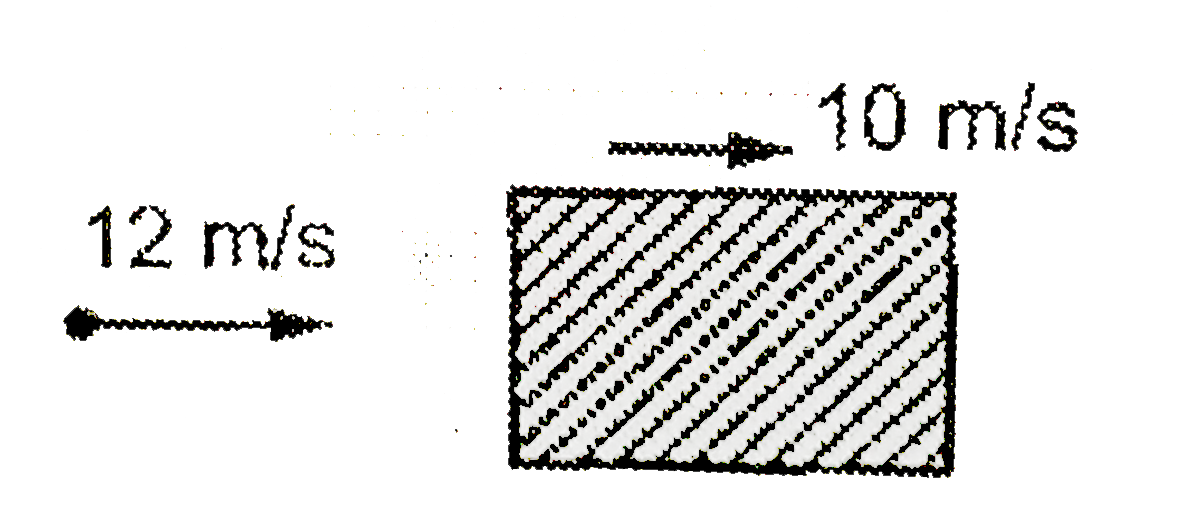A lighter particle moving with a speed of 10ms−1 collides with an object of double its mass moving in the same direction with half its speed. Assume that the collision is a one dimensional clastic collision. What will be the speed of both particles after the collision?Solution in Tamil

Let the mass of the first body be m which moves with an initial velocity, U1=10ms−1
Therefore, the mass of second body is 2m and its initial velocity is u2=12u1=12(10ms−1)
v1(m1−m2m1+m2)u1+(2m2m1−m2)u2
v1=(m−2mm+2m)10+(2×2mm+2m)5
v1=−(13)10+(43)5=−10+203=103
v1=3.33ms−1
v2(2m(1)m1+m2)u1+(m2−m2m1+m2)u2
v2=(2mm+2m)10+(2m−mm+2m)5
v2=(23)10+(13)5=20+53=253
v2=8.33ms(−1)
as the two speeds v1andv2 are posiitive , they move in the same direction with the veloxities 3.33ms−1and8.33ms−1, respectively.
Topper's Solved these Questions
- WORK, ENERGY AND POWERBook:FULL MARKSChapter:WORK, ENERGY AND POWERExercise:Textual Questions Solved (I. Multiple Choice Question:)
Explore 15 Videos
- WORK, ENERGY AND POWERBook:FULL MARKSChapter:WORK, ENERGY AND POWERExercise:Textual Questions Solved (II. Short Answer Questions)
Explore 5 Videos
- WAVES Book:FULL MARKSChapter:WAVES Exercise:Additional Questions Solved (Numerical Problems )
Explore 10 Videos
Similar Questions
A uniform force of (2ˆi+ˆj) N acts on a particle of mass 1 kg. The particle displaces from position (3ˆj+ˆk) m to (5ˆi+3ˆj) m. The work done by the force on the particle is
View SolutionExplain how the definition of work in physics is different from general perception.
View SolutionThe fundamental frequency of a closed organ pipe is equal to the first overtone of an open organ pipe. If the length of the open pipe is 60 cm, What is the length of the closed pipe?
View SolutionA particle of mass m moving with horizontal speed 6 m//s as shown in the figure. If m lt lt M then for one - dimensional elastic collision , the speed of lighter particle after collision will be
View SolutionA light particle moving horizontally with a speed of 12m/s strikes a very heavy block moving in the same direction at 10m/s. The collision is one-dimensional and elastic. After the collision, the particle will

View SolutionA particle of mass ‘m’ is moving with speed ‘2v’ and collides with a mass ‘2m’ moving with speed ‘v’ in the same direction. After collision, the first mass is stopped completely while the second one splits into two particles each of mass ‘m’, which move at angle 45∘ with respect to the original direction. The speed of each of the moving particle will be:
View SolutionAfter perfectly inelastic collision between two identical particles moving with same speed in different directions, the speed of the particles become half the initial speed. Find the angle between the two before collision.
View SolutionA particle of mass 'm' is moving with speed '2v' and collides with a mass '2m' moving with speed 'v' in the same direction. After collision, the first mass is stopped completely while the second one splits into two particles each of mass 'm' which move at angle 45∘ with respect to the original direction. The speed of each of the moving particle will be
View SolutionAfter perfectly inelastic collision between two identical particles moving with same speed in different directions, the speed of the combined particle becomes half the initial speed of either particle. The angle between the velocities of the two before collision is
View SolutionA particle of mass m moving with velocity v collides with a stationary particle of mass 2m, makinginelastic collision. The speed of the system after collision, will be
View SolutionAfter perfectly inelastic collision between two identical particles moving with same speed in different directions, the speed of the combined particle becomes half the initial speed of either particle. The angle between the velocities of the two before collision is
View SolutionAfter perfectly inelastic collision between two identical particles moving with same speed in different directions, the speed of the particles become half the initial speed. The angle between the velocities of the two before collision is:
View SolutionA particle of mass m moving with velocity v is collide with a stationary particle of mass 2 m . The speed of the system , after collision will be ……….
View SolutionAfter perfectly inelastic collision between two identical particles moving with same speed in different directions, the speed of the particles became half the initial speed. The angle between the velocities of the two before collision is
View SolutionAfter perfectly inelastic collision between two identical particles moving with same speed in different directions, the speed of the particles became half the initial speed. The angle between the velocities of the two before collision is
View Solution